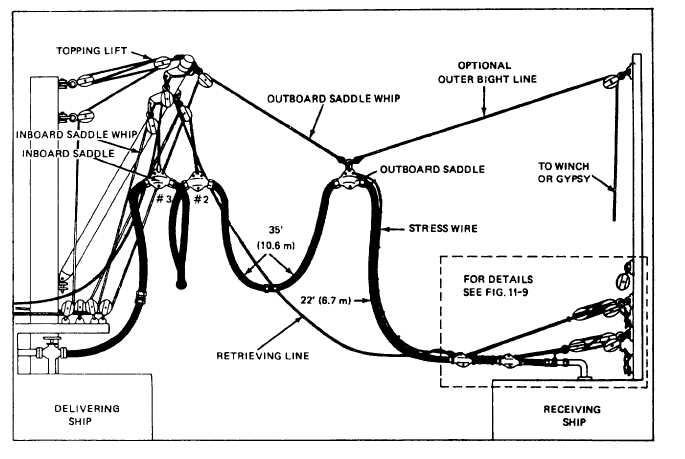| |
and keep station. These factors not only allow com-
manders a wider latitude in choosing a fueling course
but also facilitate the use of antiaircraft batteries should
the need arise. Additionally, the high suspension on the
hose affords fair protection for it in rough weather.
Ordinarily, in the span-wire method, saddle whips
and the retrieving line are of wire; but when the
necessary winch drums are not available and winches
with gypsy heads are available, 3 1/2-inch, double-
braided nylon line may be substituted for one or more
of the whips. A wire rope retrieving whip is mandatory
in double-probe rigs.
CLOSE-IN METHOD
As stated before, the close-in method of fueling is
used when the delivering ship is not equipped with the
span-wire rig or the receiving ship does not have a pad
eye strong enough to hold a span wire.
In the close-in rig, the hose is supported by whips
leading from the hose saddles to booms, king posts, or
other high projections on the delivering ship. When the
rig is used to fuel ships larger than destroyers, the
outboard bight of hose may also be supported by an
outer bight line (fig. 4-28) leading from the outboard
saddle to a high point on the receiving ship. The outer
bight line is passed to the receiving ship by means of the
hoseline messenger.
On the receiving ship, the same preparations are
made as for receiving the span-wire rig except that an
additional 12- or 14-inch snatch block must be shackled
to a high, convenient, and adequately tested point above
where the hose will come aboard. Such other blocks as
are necessary to fairlead the bight line to a winch must
also be rigged. A small pendant should be reeved
through this set of blocks to quickly haul the outer bight
line through the blocks and to the winch. The outer bight
is used to help haul the hose to the receiving ship and,
once the hose is secured, is tended in the same manner
as are the saddle whips.
STREAM METHOD
There are several transfer rigs used to replenish
provisions and stores. Some are suitable for heavy
Figure 4-28.–Close-in rig.
4-33
|

